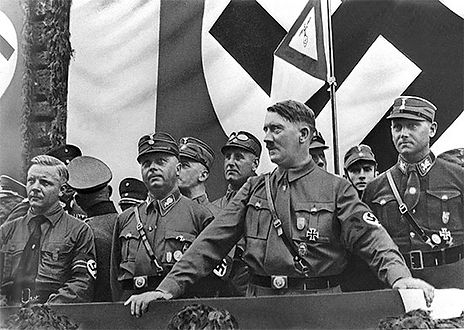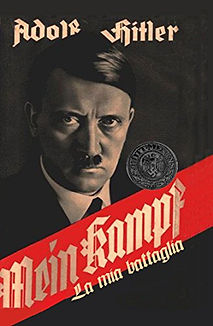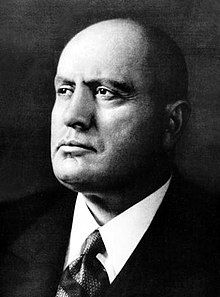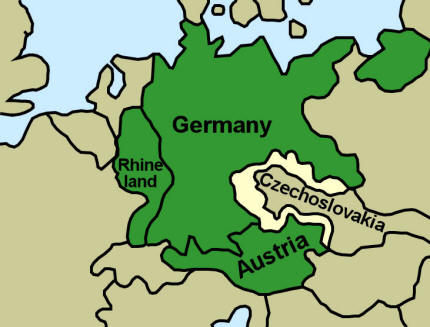World War II
Leading up to WWII
Some might argue that one of the main factors that caused the Second World War was the economic depression in the late 1920s, which added on to the unfair treaty of Versailles, caused political instability in Germany, and an angry crowd. All of which were the perfect conditions for the breeding of a new monster that would cause the deaths of tens of millions and the cruel genocide of the Jewish race--- Hitler and his Nazi Party.
In the late 1920s, there had been a boom in world trade. The USA was the richest nation in the world. American business was the engine driving the world economy. Everyone traded with the USA. Most countries also borrowed money from American banks. As a result of this trade, most countries were getting richer. This economic recovery from World War 1 helped to reduce international tension. However, one of the League’s leading figures predicted that political disaster might follow if countries did not co-operate economically. He turned out to be right.In 1929, the economic disaster did strike. In the USA, the Wall Street Crash started a long depression that quickly caused economic problems throughout the world, especially in Germany where the government is still struggling to pay the war guilt clause and still on the long road to economic recovery. Such problems affected relations in the world, which was further affected by changes in leadership.
Due to Germany facing unemployment, poverty, and chaos, the people were extremely upset and turned to Hitler who promised the people to restore Germany to its former glory. Japan too was affected, as their main export was silk to the USA, but due to the depression, the US has imported less silk and resulted in less income for the Japanese, rendering them unable to buy the raw materials and food they need.
As a result, the Japanese army invaded Manchuria from 1931-1933 to gain the raw materials they need. Such expansionist plans by the Japanese would eventually get them to invade Southeast Asia and China, and eventually get themselves into a fight with the US whom they believed are in the way of their plans. At the time, the League of Nations could do little to the situation, in Manchuria, which left China even weaker. In Italy, the Abyssinian Crisis of 1935-1936 left the impression of the League of Nations even worse as the League failed to stop Italian aggression. Mussolini, the fascist leader of Italy tried to build an overseas empire to distract the people’s attention from the difficulties the government faced. By then, many nations had already begun rearming themselves after seeing Germany leave the league in 1934 and openly rearming.
At that point, the League had fallen apart and had almost no more influence on its members. The negligence of the League’s leaders can be seen as one of the main causes for the sudden shift in power and allowing such radical change in the German government, as they were too busy dealing with their own economic difficulties that they forgot about the ticking time bomb that is- Germany. Soon, the nations such as Germany, Japan and Italy would band together to form the Axis powers, through the Pact of Steel or the tripartite.
German expansion and militarism
The beginning of Hitler putting his plan into action was 1933, where he followed Japan’s example and pulled out of the League. At that point of time, Hitler had ordered the rearmament of the German army. Hitler had violated the Treaty of Versailles but he rearmed in secret, assuring the League that he did not desire rearmament- and only showing a small portion of its rearmament to show that it only wanted to rearm due to the other League members not doing the same. The drafting of unemployed men into the army not only strengthened the Army but also appeased the people as he had delivered his promise to fight unemployment.
By 1935, Hitler openly staged a massive military rally celebrating the German armed forces. In 1936, he even introduced conscription to the army. The collapse of the League of Nations Disarmament Conference in 1934 encouraged the rearming of German forces and showed that the major powers are not willing to disarm. Surprisingly, Britain encouraged the rearmament of Germany. The reason being, the British wanted a strong buffer between the west and the communists to the east. Britain helped dismantle the Treaty of Versailles by signing an agreement in 1935, allowing Germany to increase its navy to up to 35% of the size of the British navy. By 1936, 12.4% of German spending went into armaments, which increased to 23% by 1939. From 1932 to 1939, the number of warships increased from 30 to 95, the number of aircraft increased from 36 to 8,250 and the number of soldiers from 100,000 to 950,000.
In March 1936, Hitler took his first really big risk by moving troops into the Rhineland area of Germany. The Rhineland was the large area either side of the River Rhine that formed Germany’s western border with France and Belgium.
The demilitarization of the Rhineland was one of the terms of the Treaty of Versailles. It was designed to protect France from invasion from Germany. It had also been accepted by Germany in the Locarno Treaties of 1925. Hitler was taking a huge gamble. If he had been forced to withdraw, he would have faced humiliation and would have lost the support of the German army (most of the generals were unsure of Hitler). Hitler knew the risks, but he chose the right time and place to activate his plan.
-
France and the USSR had just signed a treaty to protect each other against attack from Germany. Hitler used this agreement to claim that Germany was under threat. He argued that in the face of such a threat he should be allowed to place troops on his own frontier.
-
Hitler knew that many people in Britain felt that he had a right to station his troops in the Rhineland and he was fairly confident that Britain would not intervene. His gamble was over France. Would France let him get away with it?
As German troops entered the Rhineland, Hitler and his generals sweated nervously, worried that France would act against Germany. Despite the rearmament, the German army was still no match for the French Army at the time. The German army still lacked essential equipment and air support. In the end, Hitler’s luck held and the French did not intervene.




The Spanish Civil War
In 1936 a civil war broke out in Spain between supporters of the Republican government and the right-wing rebels under General Franco. A civil war in a European state would have been an important event anyway, but this one was especially important as it had an international dimension.
Stalin’s USSR supported the Republican government (in the form of weapons, aircraft, and pilots). Thousands of volunteers from around 50 countries joined International Brigades to support the Republicans. At the same time, Mussolini and Hitler expressed their support for General Franco who shared their worldview.
The British and French refused to be directly involved in the conflict but did send weapons to the Republican army. Italy and Germany however, contributed to the Nationalist war effort. Italy sent thousands of “volunteers” to Spain to fight. Hitler sent aircraft and pilots who were pivotal to the victory of the Republicans. Thanks partly to Hitler’s help, the Nationalists won the war and a right-wing dictatorship ruled Spain for the next 36 years.
Anschluss with Austria
With the successes of 1936 and 1937 to boost him, Hitler turned his attention to his homeland of Austria. The Austrian people were mainly German, and in “Mein Kampf”, Hitler had made it clear that he felt that the two states belonged together as one German nation. Many in Austria supported the idea of union with Germany since their country was economically weak. Hitler was confident that he would be able to unify the two nations to form a “Greater Germany”. In fact, Hitler tried to take over Austria in 1934 but on that occasion, Mussolini stopped him. Now, the situation has changed and they both are now allies.
There was a very strong Nazi party in Austria. Hitler encouraged the Nazis to stir up trouble for the government. They staged demonstrations calling for union with Germany. They caused riots. Hitler then told the Austrian Chancellor Schuschnigg that only Anschluss (political union) could sort these problems out. He pressurized Schuschnigg to agree to Anschluss. Schuschnigg appealed to the league and its leaders to issue sanctions or a warning to Germany. Unfortunately for him, France and Britain failed to deliver a strong statement leaving Schuschnigg no choice but to call a plebiscite (a referendum). Hitler was not prepared to risk losing Austria and simply sent his troops into Austria in March 1938, supposedly to guarantee a trouble-free plebiscite. Under the watchful eyes of the Nazi soldiers, 99.75% of the population voted for Anschluss.
Anschluss was completed without any military confrontation with Britain and France. Chamberlain, the prime minister of Britain, believed that the treaty of Versailles was wrong to separate the two nations. Lord Halifax of Britain even guaranteed Hitler that the British would not interfere with an Anschluss. Once again, Hitler took the risk and it paid off.
Demand for the Sudetenland
After this, Hitler will once again make demands of Czechoslovakia, a nation formed by Germany and Austria-Hungary’s defeat after WW1. Hitler argued that there were millions of Germans living in Czechoslovakia, thus giving them the right to the Sudetenland. After discussion, Britain and France did not intervene and granted Germany the territory. However, Germany has yet to have gained full control over Czechoslovakia; which was their desire. Czechoslovakia ceased to be a sovereign nation on 15 Mar; the western portion became a German protectorate, the eastern portion divided up between the newly proclaimed Slovakia and Hungary, while Poland took a small piece of territory in the fray as well.
Claims on Memel
1939 German ultimatum to Lithuania was an oral ultimatum presented to Juozas Urbšys, Foreign Minister of Lithuania, by Joachim von Ribbentrop, Foreign Minister of Nazi Germany, on 20 March 1939. The Germans demanded that Lithuania give up the Klaipėda Region (also known as the Memel Territory), which had been detached from Germany after World War I, or the Wehrmacht would invade Lithuania. After years of rising tension between Lithuania and Germany, increasing pro-Nazi propaganda in the region, and continued German expansion, the demand was expected. The ultimatum was issued just five days after the Nazi occupation of Czechoslovakia. The four signatories of the 1924 Klaipėda Convention, which had guaranteed the protection of the status quo in the region, did not offer any material assistance. The United Kingdom and France followed a policy of appeasement, while Italy and Japan openly supported Germany. Lithuania was forced to accept the ultimatum on 22 March. For Germany it was the last territorial acquisition before World War II; for Lithuania it was a major downturn in its economy and morale; for Europe it was a further escalation in pre-war tensions.





Post WW2
The Yalta conference.
In February 1945, it was clear that the Germans were losing the war in Europe. The Allied leaders that held a conference in Yalta, Ukraine to discuss what would happen to Europe after Germany's defeat. The Yalta conference went well. Despite differences, the Big Three were still able to agree on some important matters.
Agreements:
1) Stalin would go to war with Japan once Germany surrenders.
2)They agreed that Germany would be divided into 4 zones-American, French British and Soviet.
3)They agreed that liberated countries would be allowed to hold free elections to choose the government they want.
4)The Big Three agreed to join the United Nations, which aims to keep the peace after the war.
5)They decided to hunt and punish war criminals who were responsible for Genocide
6)The Big Three agreed that eastern Europe should be seen as a "Soviet Sphere of influence"
Disagreements:
1)The Polish border. Stalin wanted the USSR border to move westwards into Poland. He argued that Poland can then move its border into Germany. Churchill did not approve of this, but he knew that there was not much he could do because most of eastern Europe was under Soviet hands Roosevelt also did not approve of this, but Churchill persuaded him to accept it as long as the USSR did not interfere in Greece where they were trying to prevent the communist from taking over.
The Potsdam conference
In May 1945, three months after the Yalta conference, Allied troops reached Berlin, Hitler committed suicide, and the war in Europe was won. The Big three arranged for another conference in the Berlin suburb of Potsdam, in July 1945. But in the five months since Yalta, a great number of things have changed that would affect the relationships between the leaders.
Firstly, Stalin's army was occupying most of Eastern Europe. The red army had liberated country after country in Eastern Europe, but instead of withdrawing his troops, Stalin left them there. Refugees were fleeing from these countries fearing a communist takeover. Stalin set up a communist government in Poland despite majority of the population objecting to this. He insisted that the control over Eastern Europe was to safeguard against possible future attacks.
Secondly, America had a new president. After President Roosevelt died, President Harry S Truman took over. President Truman was a very different man. He was much more anti-communist and was very wary about Stalin's actions. All his advisors thought that the USSR was poised to take over Europe.
Thirdly, America had successfully tested the atomic bomb. At the start of the Potsdam conference, President Truman told Stalin about it. To make things worst, Churchill was defeated in the July elections, and he was replaced, Prime Minister Clement Attlee. In the absence of Churchill, the conference was dominated by suspicion and rivalry of each other.
Stalin strengthens his grip
The Potsdam conference ended with nothing much achieved. By 1946, Poland, Romania, Bulgaria and albania all had communist governments that were loyal to Stalin. The Western Powers were all alarmed by the USSR's take over of Europe. Even though the Big Three had agreed on a "soviet sphere of influence" they had not expected total communist domination. They felt that it should have been possible for the countries in Eastern Europe to be democratic yet friendly to the USSR. Stalin saw his policy in Europe as security, but Truman could onl see it as a spread of communism.
The Berlin Blockade
In 1948, the mistrust between the 2 blocs was so great that leaders were talking in public about the possibility of war. Instead of running down arms expenditure, as you would expect after a war, the 2 sides actually increased their stock of weapons.
After the war, Germany was divided into 4 zones. The zones owned by America, France, and Britain were originally known as Trizonia, but from 1949 it was known as West Germany. Stalin did not want Germany to recuperate for the fear of another war, but the allies knew that Germany's economy must be allowed to recover if not its people would suffer. In 1948, the allies reformed West Germany's currency and there were signs that its economy was improving.
Stalin found the allies actions provocative, but could not do anything to stop it. However, he knew that he could stamp his authority on Berlin, which was deep within East Germany. In 1948, Stalin cut off supply lines, blocking the 2 million strong population in West Berlin from outside help. This was a clever move, as if the American tanks tried to ram down the roadblocks, Stalin would see it as an act of war. However, President Truman was not about to give up. He wanted Berlin to be a symbol of freedom behind the iron curtain.
Hence, since the only way into Berlin was by air, the Allies decided to airlift supplies into West Berlin. Tensions were high as the first planes took off, as everyone wondered they will be shot down, resulting in war. However, as the planesflew over Soviet territory, no shots were fired. The planes got through and for the next 10 months, Berlin was supplied by a constant stream of planes(3 per minute). In 1949, Stalin realized that the blockade would not make the Allies give up Berlin, and reopened communications.
NATO and the Warsaw Pact
During the Berlin Blockade, the war between the USA and USSR seemed like a very real possibility. At the height of the crisis, Allied leaders met in Washington DC and signed an agreement to work together. This new organization was called the North Atlantic Treaty Organization(NATO)
The USSR took no notice of the new organization, until 1955 when West Germany was allowed to join NATO. This triggered terrible reminders of the Second World War, and the USSR, along with surrounding communist countries, formed the Warsaw Pact. The countries agreed to defend one another if any of them were attacked. They also agreed not to interfere in each country's internal affairs. Of course, the USSR still had a great deal of influence over the communist countries.
Hence, the 2 blocs that formed would later pave the way for the Cold War.


